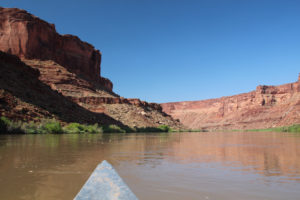 Sometimes a rock is just a rock. And sometimes it’s something more.
Sometimes a rock is just a rock. And sometimes it’s something more.
I had the occasion to experience a lot of rocks last week, in Labyrinth Canyon on the Green River in Utah. It was a hot and buggy time for a river trip, but our small party was driven by vacation schedules and buoyed by ignorance: of the five of us, only I had been there before, and that had been half a lifetime earlier, when I was new to the Southwest and had scarcely any frame of reference for its complicated landscapes, its extreme moods, its three dimensionality, its depthless sandstone cliffs.
So the place felt new, and wild. Fed by Colorado snowmelt, the river rushed, fast and brown, its smooth brown surface punctuated now and again by branches and even whole trees ripped from some bank somewhere. Navigating our canoes and kayak required little more than paddling to remain pointed downstream.
When the river’s high like that, the bigger challenge is camping. Sandbars are gone, and it takes real alertness to detect the campsites tucked up behind the wall of willows and tamarisks that line the banks—and real work to pull the boats in to the small and often hidden openings in the face of the current.
There were more challenges to come. On the first night we stayed at a breezy open campsite under thick-trunked cottonwood trees. On the second day the upcanyon wind dropped away. That made it easier to steer. But the downside became clear that evening. We’d camped at the entrance to a steep-walled side canyon, a lovely alcove with sandy campsites and a still backwater where we could swim to cool off all afternoon. But in the evening the mosquitoes came out: a few, here and there. By morning, many more. Breakfast was a matter of swatting and hopping; a visit to the camp toilet tucked in an oak thicket, a torment. It was with relief that we finally packed everything onto the boats and set onto the water again, trailed by clouds of bugs.
It got worse from there. We had to beat a full-scale retreat from our first pee spot that morning, a muddy slough intensively humming with mosquitoes and gnats. That evening we tried to find refuge from the bugs by camping up high, on a stony hill 100 feet above river level. But even there they found us, swarming us by the dozens and hundreds as we set up tents and cleaned up after dinner.
Between the heat and the bugs, it was turning into a strenuous trip. It was very unlike my long-ago first trip, which had been in cool early spring, at a lower water level and with many fewer bugs. On our fourth and last night, I knew, it sure would help to find a spot less amenable to mosquitoes—which meant less vegetation. But where?
The answer showed itself around one of the final bends before our takeout. The river’s outside curve ran up against big rocks and the current was enough to have scoured out much of the vegetation. The place faced the afternoon sun and was hot as hell, but occasionally a river breeze stirred. I had hope that it was open enough to keep the bugs away.
We set up a shade tarp over a collection of jagged sandstone boulders, pale ones polished to a darker finish on top with desert varnish, their undersides eaten away into irregular cavities by wind and water—Swiss cheese rocks that made a natural place to set up a camp kitchen. After the sun sank behind the rim—a welcome relief on this, the longest day of the year—we cooked our noodles and drank the trip’s last rations of beer and wine.
And that’s when it happened. Though the boulders were clean and of a perfect height, they lacked flat surfaces. I’d had to stick a stone under the Coleman stove to keep it parallel to the ground, and there were only a few places where plates and drinks could be arranged without sliding down.
I’ve been here before, I suddenly thought. This set of pocked boulders—I’ve cooked here before, with the same pleasure in finding a good campsite, the same challenges in balancing the components of the camp kitchen on rocks that refuse to offer flat surfaces. Even if I couldn’t remember it consciously, I had some sort of muscle memory that I’d used those rocks in the same way once before.
Twenty-five years later, it was clear: this was simply the sort of place that people camp, a stopping point that drew river runners in, a natural spot to set up to cook. For a moment, I could ignore the intervening half lifetime, and remember how it was to be brand new in this landscape.
Maybe it’s true that you can’t stick a paddle in the same river twice, that the flow of water and of human lives offers no repeats. But stone lasts, at least across the short timeline that we get to experience here. Occasionally it grants us the gift that for us, too, the years might drop away.

